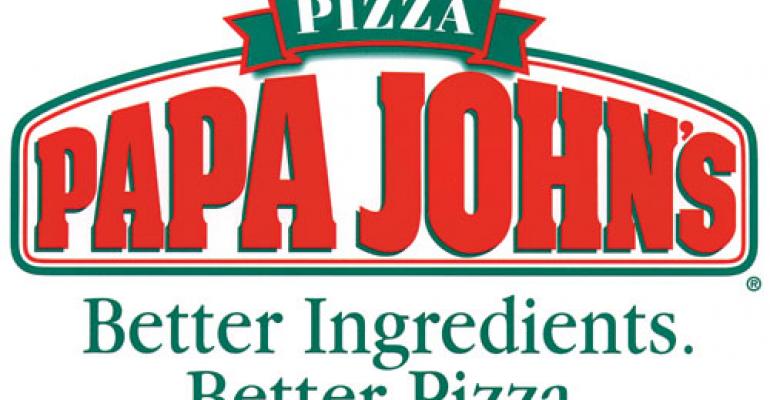Papa John’s International Inc. told investors during an earnings conference call that growing its system of pizza restaurants, both in the United States and abroad, would power sustainable growth, even as its main competitors stir up the segment with aggressive pricing and discounting.
Officials of the 3,516-unit chain credited the development incentive program of the past few years for bolstering its domestic franchise system and said the imminent hiring of a new president for its international division, expected within the next 30 days, would spur growth and eventual profitability of Papa John’s restaurants abroad.
Papa John's spoke with investors after reporting a dip in net income for the June 27-ended second quarter, to $13.2 million, or 49 cents per share. Revenue rose 4.5 percent to $280.6 million, reflecting more restaurants in operation and a 0.4-percent bump in domestic systemwide same-store sales. Click here for more on Papa John's latest results.
Papa John's incentive program for domestic franchisees waives the up-front $25,000 fee, but the company sees that as a worthy investment because “we were committed to store growth,” said founder and co-chief executive John Schnatter.
“We think we have a lot of runway in the U.S. and worldwide," he said. "It’s the not just the number of stores, but the numbers in the stores, that we care about the most, so we’ll do this in a methodical way that’s beneficial to the store, the operator and Papa John’s.”
Schnatter added that interest in Papa John’s franchise system continues to be high among potential operators because of the program, and that the waiver of the franchisee fee and lower rates on royalties have not diminished the quality of applicants.
“I’m going to make some people mad, but we think [recent applicants] are higher-quality,” said president and co-chief executive Jude Thompson. “We love the way the system looks today. You look at some of the ‘new blood,’ and the way they work and are attracted to the brand’s core beliefs, they buy in. … We feel it’s all adding up and is part of this plan, where we have an opportunity and we want to run.”
Papa John’s opened 29 net domestic units in the second quarter, making 33 total new units in the United States in the first half of the year, well on the way to the company’s goal of 40 to 60 new domestic restaurants for 2010. The company has agreements for 270 new units in the United States, about two-thirds of which are scheduled to open in the next two to three years.
Thompson said Papa John’s was open to extending the development incentives for U.S. franchisees.
“We believe we could put 500, 600 more stores in the U.S., and we think it’s smart to put development incentives in place because [the new operators] become longtime franchisees contributing royalties and to the marketing fund,” he said. “It’s a little short-term pain for a lot of long-term gain. We want to get to store No. 4,000, and at that level, that $25,000 [waived fee] is a steal.”
The shuttering of 25 stores in Saudi Arabia contributed to a net closing of four stores in Papa John’s international division in the quarter, but the company expects to begin reopening many of those units soon, and it is expanding to Chile, the Philippines and Panama. When the new international president, to be announced soon, comes on board, he or she will oversee a development pipeline of 1,200 stores to be opened over the next seven years, the company said.
Thompson said the company expects the international division to be profitable on a run-rate basis by late 2011 and on a full-year basis by 2012.
Other highlights from the call included:
• Company officials pointed out that the second quarter was the fifth straight quarter of transaction growth. Chief marketing officer Andrew Varga said the company’s $10 large-pizza offer, which it discontinued about six weeks ago, brought in new and lapsed users, guarding against business lost to Pizza Hut’s and Domino’s ongoing aggressive promotions.
“We’ve grown our market share when the pizza category was declining the last few years, and we’re holding our own in a growing category now, with our two largest competitors fighting on price and big media commitments,” Varga said. “Market share isn’t a one-quarter battle. We’re not going to get in deeper with $10 large-pizza pricing. We’ve been off it for six weeks, and we like what we see.”
Papa John’s said in its earnings release that the aggressive pricing environment would continue to pressure margins for the balance of the year.
• Papa John’s reported significant improvements in labor costs at the unit level in the second quarter. Thompson credited the reduction in staff at mid-day, the switch of assistant managers from a salaried to an hourly pay structure, and a tip-credit program begun with Papa John’s delivery drivers with the savings. Reducing the number of menu items also improved operations, he added.
“We took out a number of SKUs to make sure we keep our store-level operations as simple as possible so we can replicate them and be consistent,” he said. “The American Customer Satisfaction Index gave us very high scores on pizza quality, which suggests that was a smart move to make.”
• Officials also expressed excitement about the chain’s multiyear partnership with the National Football League. Papa John’s had its highest single-day sales record during this year’s Super Bowl, selling more than 900,000 pizzas.
Louisville, Ky.-based Papa John’s operates or franchises restaurants in all 50 states and 28 foreign countries.
Contact Mark Brandau at [email protected].




